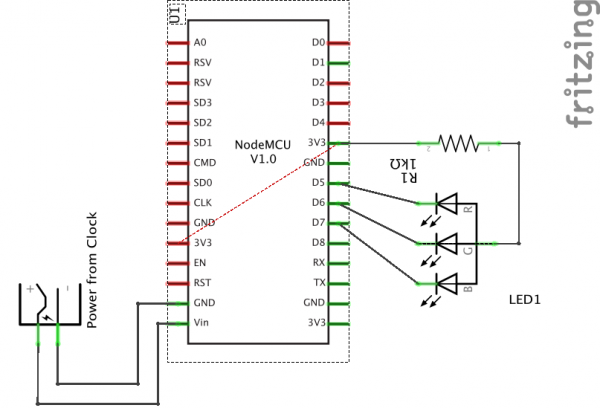Difference between revisions of "SpaceState ESP"
From
(→Steps) |
|||
| Line 7: | Line 7: | ||
}} | }} | ||
| − | I wanted to see if the TkkrLab hackerspace is open on my clock. For this I used an nodeMCU with a RGB led to request the spaceapi every 10 mins and display open (green) or closed (red) status. | + | I wanted to see if the TkkrLab hackerspace is open on my clock. For this I used an nodeMCU with a RGB led to request the spaceapi every 10 mins and display open (green) or closed (red) status. The nodeMCU is a developer board with an ESP8266 / ESP12-E chip. There are a few different types of nodemcu's, check out this article for [https://frightanic.com/iot/comparison-of-esp8266-nodemcu-development-boards/ more information about these] |
<gallery> | <gallery> | ||
| Line 15: | Line 15: | ||
File:Nodemcu spacestate breadboard.JPG | File:Nodemcu spacestate breadboard.JPG | ||
</gallery> | </gallery> | ||
| − | |||
=Resources= | =Resources= | ||
| Line 27: | Line 26: | ||
* source code for nodeMCU : https://github.com/zeno4ever/spacestatus_ESP | * source code for nodeMCU : https://github.com/zeno4ever/spacestatus_ESP | ||
* Library for json processing https://bblanchon.github.io/ArduinoJson/ | * Library for json processing https://bblanchon.github.io/ArduinoJson/ | ||
| + | * Arduino IDE for uploading source to nodeMCU | ||
=Steps= | =Steps= | ||
| Line 37: | Line 37: | ||
The clock I have has a 6v that is connected to the Vin and GND of the nodeMCU | The clock I have has a 6v that is connected to the Vin and GND of the nodeMCU | ||
| − | + | * Check the clock you want to use if there is enough space inside to put nodeMCU insite. | |
| + | * Check if you can use the power of the clock and this is good for Vin. In my case i had 6 V, this in within the range of 4.5V ~ 9V. If you have a other version of nodeMCU check the documentation. | ||
| + | * Download the source and change the settings for your hackerspace. | ||
| + | * Upload code to nodeMCU via USB | ||
| + | * Connect the RGB LED and power in the the nodeMCU | ||
| + | |||
| + | |||
| + | ===LED remarks=== | ||
| + | If you order a LED chip check what type you buy, you have commen anode and commen cathode types. These have to be connected different I uses an common anode. I include setting you can change. I have no tested this part so there may more changes needed to make this work. | ||
| + | |||
| + | I also use one resistor since i only show one color all times. If you want to use more then one color at a time then you should use a resistor per color, so 3 for R,G,B. | ||
Revision as of 18:10, 9 April 2017
I wanted to see if the TkkrLab hackerspace is open on my clock. For this I used an nodeMCU with a RGB led to request the spaceapi every 10 mins and display open (green) or closed (red) status. The nodeMCU is a developer board with an ESP8266 / ESP12-E chip. There are a few different types of nodemcu's, check out this article for more information about these
Resources
Parts List
- Clock
- nodeMCU v2
- 10 mm RGB LED
- 1x 1K resistor
Software
- source code for nodeMCU : https://github.com/zeno4ever/spacestatus_ESP
- Library for json processing https://bblanchon.github.io/ArduinoJson/
- Arduino IDE for uploading source to nodeMCU
Steps
I used male breadboard connectors to connect everything to the nodeMCU, you can solder the RGB led directly on the wire (with one resistor on the anode (+))
The clock I have has a 6v that is connected to the Vin and GND of the nodeMCU
- Check the clock you want to use if there is enough space inside to put nodeMCU insite.
- Check if you can use the power of the clock and this is good for Vin. In my case i had 6 V, this in within the range of 4.5V ~ 9V. If you have a other version of nodeMCU check the documentation.
- Download the source and change the settings for your hackerspace.
- Upload code to nodeMCU via USB
- Connect the RGB LED and power in the the nodeMCU
LED remarks
If you order a LED chip check what type you buy, you have commen anode and commen cathode types. These have to be connected different I uses an common anode. I include setting you can change. I have no tested this part so there may more changes needed to make this work.
I also use one resistor since i only show one color all times. If you want to use more then one color at a time then you should use a resistor per color, so 3 for R,G,B.





